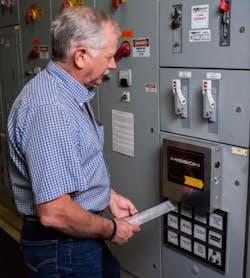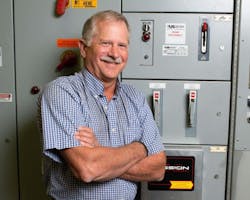Mission Empowers RUSA to Solve Problems Before They Happen
Roseburg Urban Sanitary Authority (RUSA), based in Roseburg, Ore., has been a Mission customer since 2010 and uses M800 Series Mission Communications remote terminal units (RTUs) at nine pumping stations to monitor wet well levels and pump runtimes within the collection system. Jim Baird, general manager for RUSA, is responsible for overseeing all daily operations within the utility. He has used Mission RTUs in various positions nearly since the company was founded.
The service area spans approximately 15.6 sq miles and encompasses 11,000 connections, nine pump stations, 4,150 manholes, and about 160 miles of sewer pipeline. RUSA utilizes two treatment facilities. One is a traditional treatment facility with a dry weather average rating of 7.9 mgd and a hydraulic capacity of 22 mgd in the winter. The other treatment facility is a natural treatment system, which covers 340 acres and is used to cool and reduce the nutrients in discharge water before it is returned to the South Umpqua River.
RUSA Saves Money & Time
RUSA implemented the Mission system when Baird was initially hired as engineering operations manager. Prior to that time, RUSA used auto-dialers to alert the team of contracted operators of issues with the system. Baird explained, "An auto-dialer simply tells you when something has gone wrong. That is all it can do. That then requires you to go to the station and figure it out." RUSA officials and the contracted operators recognized a need for a system that provided more insight into potential problems.
Right before Baird was hired, the contracted company had submitted a proposal for a traditional SCADA system, but he proposed the Mission system as a cost-effective alternative. Baird said, "I ran the numbers for what it would cost to support the radio system, and that proposal was stopped just based on those numbers." Implementing the traditional SCADA solution would have required RUSA to update the network of radios according to FCC narrowband requirements. This would have cost $24,000 alone, not accounting for repeaters and regular tower maintenance.
Mission devices utilize the public radio data network, also known as the cellular network, which is maintained by the major carriers. Additionally, the Mission technology obsolescence guarantee covers the cost of replacement radios as cellular network technology evolves.
Baird explained that in addition to saving money, the 123SCADA web portal has allowed RUSA to save time. "Mission allows you to get snapshots of all your lift stations 24/7 and in theory, solve problems before they happen," Baird said. Though RUSA officials were initially impressed with Mission service, they opted to retain the auto-dialers as a redundant system because the area is subject to severe weather events during the wet winter season.
In late spring, Roseburg and the surrounding area were hit with 2 ft of snow accompanied by a nearly week-long power outage. The Mission system was critical to operations during this time because the lift stations were non-functional. "The chief mechanic was able to look at the 123SCADA app on his phone and figure out where to send a generator. We have a number of portable generators, but not one for every station," he explained. "He checked the level at each station to see how close it was to overflowing, and that allowed him to tell his crew where to take the generators first." Baird said that the Mission system was so helpful during this weather event that RUSA officials and the contracted operators have decided to remove the redundant auto-dialers and solely rely on Mission alarm call-out notifications to alert them of potential issues with the application.
Mission Aids Daily Operations at RUSA
Aside from relying on Mission data during severe weather events, RUSA monitors pump runtimes to help identify potential issues with the equipment and schedule preventative maintenance. "Trending is what it's all about when you're looking for failures. We use trending data to set alarms and intuitively try to figure out what is going on," Baird explained. "You can do it from your desk, and you don't even have to go out to the station but can still analyze a potential problem."
Mission RTUs also are used to send data regarding wet well levels. Each wet well has three high-level sensor points to ensure operators are notified in the event of a potential overflow. Baird said, "No one thing should ever shut you out of pumping or alarming." The first point is the primary high-level, which is measured by an ultrasonic level sensor. The second is a redundant high-level, measured by a conductive probe. Finally, they have configured an overflow alarm setpoint, which they refer to as a high-high point. Baird explained that sewerage authorities in Oregon are required to have an overflow point for each wet well. If the well were to overflow, the date and time stamp of that level would be used when the event is reported to the state.
Additionally, the operators have wired a service mode relay to a light in each facility. The light illuminates when RTUs are in service mode, which is helpful to operators during their weekly maintenance visits to each site. The maintenance routine includes inspecting wet wells, pump equipment, and hatches. At sites with fixed generators, operators also exercise them for 30 minutes and ensure there is sufficient fuel in the event of a power outage.
Long-Time Mission Proponent
Baird is a strong advocate of Mission service. In a previous position, he designed pump station control panels for wastewater and storm water collection systems. When his clients requested a cost-effective monitoring system, Baird recommended Mission RTUs. "It is by far the easiest to implement and maintain. To have a map and all your stations there and the ability to view it on your laptop, desktop, or phone would seriously take hundreds of thousands of dollars if you did it in a different platform," Baird explained. "If customers didn't have a system and asked me to recommend one, I'd say 'it's really hard to beat this little box.'"
RUSA recently installed its first MyDro 850 unit to utilize the expanded I/O capabilities. Existing M800 units will be upgraded as budget allows so the utility will be able to benefit from any future enhancements to the Mission system. To learn more about the benefits of upgrading, consult the RTU Upgrade Options brochure, or contact [email protected].

